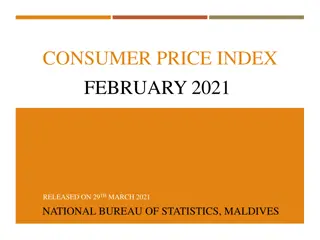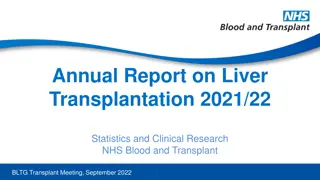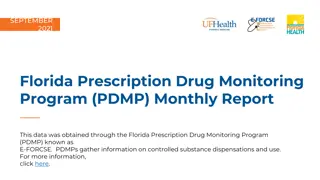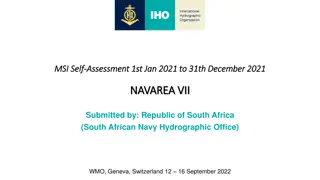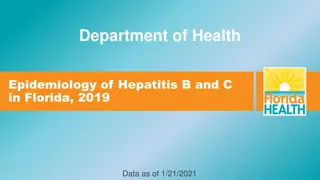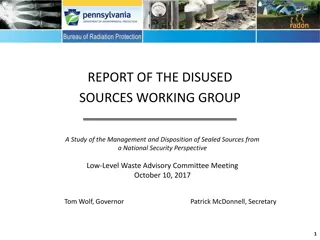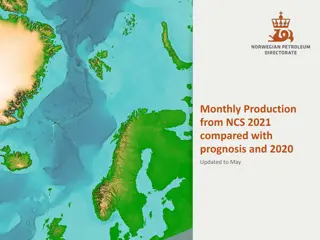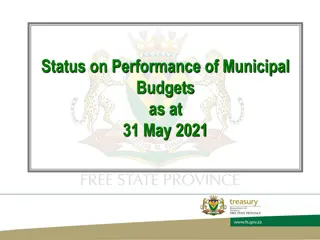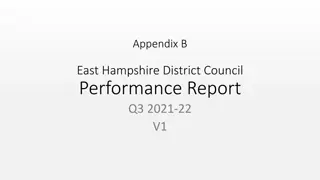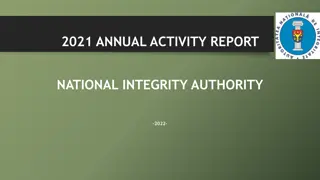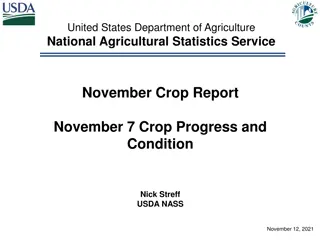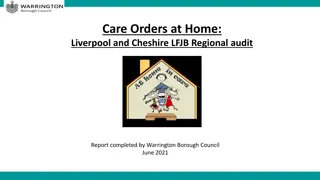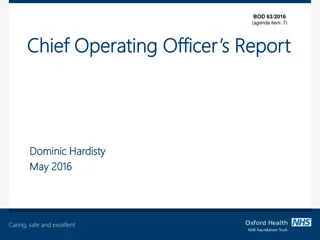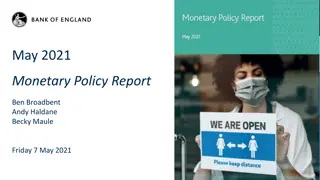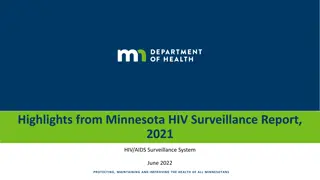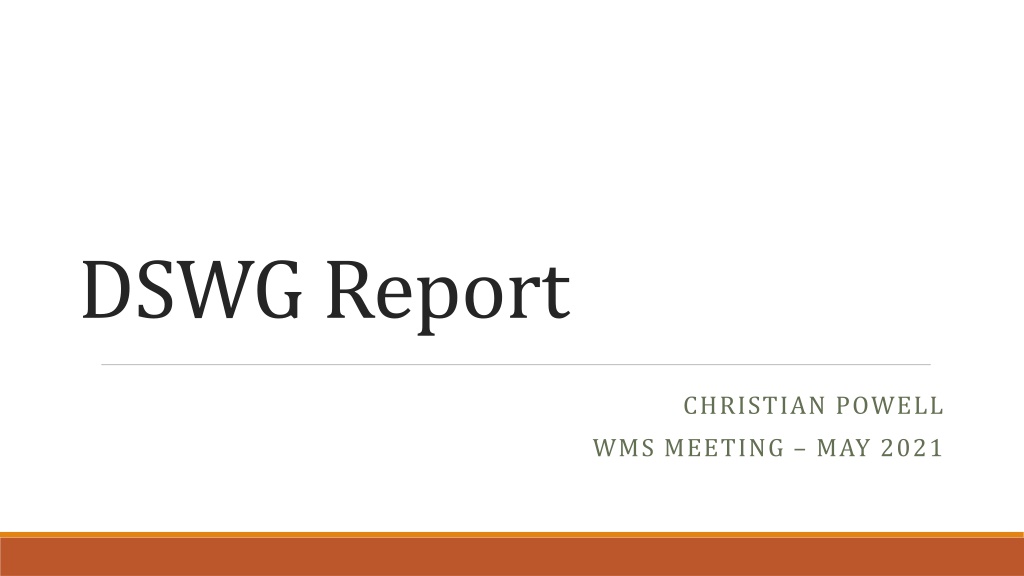
ERS Fleet Performance Analysis - Winter Storm Event 2021 Update
"Explore the detailed analysis of ERS fleet performance during the Winter Storm Event of 2021, including insights on loads, generators, obligations, and response to forced outages. Learn how ERS responded to emergency conditions and met obligations effectively."
Uploaded on | 0 Views
Download Presentation

Please find below an Image/Link to download the presentation.
The content on the website is provided AS IS for your information and personal use only. It may not be sold, licensed, or shared on other websites without obtaining consent from the author. Download presentation by click this link. If you encounter any issues during the download, it is possible that the publisher has removed the file from their server.
E N D
Presentation Transcript
DSWG Report CHRISTIAN POWELL WMS MEETING MAY 2021
Overview Previous meeting April 16 WMS Update: Winter Storm Emergency Conditions List Feb. Storm ERS ERCOT Presentation Feb. Storm Load Resource ERCOT Presentation Feb. Storm REP Demand Response ERCOT Presentation June-Sept. ERS Standard Contract Term Update DSWG Goals Update
ERS Fleet Performance Loads and Generators Monday February 15th, 2021 most significant day of ERS deployment and obligation during the Winter Event The majority of the fleet is deployed and exhausted on the same day within 12 hours of the first deployment. A few ERS Loads remain obligated into subsequent days. MW baseline significantly higher than MW actuals prior to first ERS VDI Baselines account for what demand (MW) would have been under normal operating conditions for the day most ERS Loads were consuming much lower than normal heading into the event As an ERS fleet in aggregate, the response generally met or exceeded the aggregate obligation EEA Level 3 forced outages start ~1:20am and remain in effect throughout the entire event day 4 PUBLIC
ERS Fleet Performance Load Only Demand on Sunday February 14th, 2021 shows signs of load reduction prior to the first ERS deployment Based on responses to ERCOT RFIs, this was driven by a number of factors including weather related issues, local TDSP outages, closed businesses due to weather, in response to conservation notices, and price response. As a fleet in aggregate, ERS Loads generally over-provided relative to their combined obligation during the Winter Event On average, fleet-level ERS Load reduction was 30%-35% above the combined fleet-level obligation during the first 12 hours after the first deployment (prior to majority of ERS Load fleet exhaustion) Preliminary analysis indicates ERS Load portfolios also performed relatively well during the individual deployment events ERS Loads experiencing forced outages generally performed successfully relative to their baselines and obligations Loads still provide reduction during forced outages as their demand goes to zero, which may have also contributed to over-provision 5 PUBLIC
ERS Fleet Performance Generator Only Activity on Sunday February 14th, 2021 shows export from ERS Generators prior to the first ERS deployment As a fleet in aggregate, ERS Generators generally failed to meet their combined obligation during the Winter Event On average, fleet-level ERS Generator exports were 50%-55% below the combined fleet-level obligation during the first 12 hours after the first deployment (prior to exhaustion of the ERS Generator fleet) Based on responses to ERCOT RFIs, supply constraints, refueling issues, and forced outages were the primary factors affecting performance Unlike ERS Loads, ERS Generators experiencing forced outages generally failed to perform relative to their obligations Generators are unable to perform (export) for ERS during forced outages Even prior to the forced outages, the ERS Generator Fleet was only meeting 70%-75% of its combined obligation 6 PUBLIC
Lessons learned ERS 1. Review Weather-Sensitive limitations on deployments based on Winter event 2. Discuss and add clarifying language related to ERS Renewal start date 3. Discuss modification/elimination of scheduled unavailability / planned maintenance 4. Discuss whether certain types of Loads should be prohibited from ERS participation and, if so, who should be responsible for managing prohibition 7 PUBLIC
Load Resource Response Load Resources load level starts declining on Feb. 12th List of reasoning based on RFI responses Controls affected by extreme cold temperatures resulting in shut down of processes TDSP outages affected LRs ability to return to operation and therefore meet their AS responsibility Extreme temperatures affected various fluids in the processes resulting in equipment failures Lack of raw materials during event impacted ability to make final products Fuel supply issues to back up generation Telemetry issues prevented remote control of loads Loss of other essential utilities resulting in shutdown Some oil production sites rely on trucking options to move oil and water. These were limited due to weather conditions and in some cases sites had to be shut down Supplier limitations were not able to respond and provide assistance when needed to restore processes Load Resources still not at pre-event load levels by Feb. 22nd PUBLIC 9
Load Resource Response Initial response did not meet 10 minute requirement ~70% in 10 minutes Total response ~130% sustained response during event based on telemetered responsibility at VDI ~97% sustained response during event based on telemetered responsibility at on Feb. 14th Several Failures at QSE level requiring resource level performance evaluation NPC-LPC less than RRS obligation for many resources leading up to event Oscillations during event due to telemetry issues PUBLIC 10
February Storm Items Competitive Area DR Info
Overview Initially targeted TDSP controlled outages considering substations they reported to PUCT Shifted to include ESIIDs with storm-related outages many ESIIDs had outages prior to the load shedding and were subject to TDSP load shed as well Analysis targeted ESIIDs identified with outages as well as ESIIDs Deployed for ERS Containing Load Resources deployed for RRS Previously Identified as on Indexed pricing (Day-Ahead/Real-Time) and/or 4CP responders Other ESIIDs identified as responding during the event 4 million deployed ESIIDs to analyze (3.8 million Residential, 468,000 Non-Residential Developed algorithms to identify outage ESIIDs and control group ESIIDS Algorithms varied across the load type Based on number of zero intervals (15-min) Feb 1 Feb 4 Outage ESIID - lots of zeros on Feb 15 19 compared to earlier days Control group ESIID small number of zeros throughout Some ESIIDs were neither Examined interval data for every ESIID (~8 million) 12 PUBLIC
Overview Goal was to analyze load response for all 28 days in February to capture anything happening before, during and after the event. Performed analysis generally in categories of Profile Type Created two new ones for analysis, not necessarily reporting, purposes LOWUSE for ESIIDs with very low usage (< 2 KWh per day) LIGHT for ESIIDs with > 75% night-time use Note: excluded ESIIDs with DG and WD profile types, ESIIDs with zero use for most days prior to the event Also have not yet started analysis of NOIE load reductions Baselines developed for all deployed ESIIDs: Control groups for Residential and smaller Business ESIIDs Used near-day baselines for large Business (subject to 4CP billing) Used near-day baselines for Business Load Factor ESIIDs (not subject to 4CP billing) for which sufficiently similar ESIIDs were not found Peak demands for these ESIIDs range from 5/10 KW to 700 KW MAPE: Residential 1%, Business 0.5% (based on days with no reductions) 13 PUBLIC
Competitive Res Plus Bus Load Reductions Load Reductions Feb 7 - Feb 28 24,000 22,000 20,000 18,000 16,000 14,000 12,000 MW 10,000 8,000 6,000 4,000 2,000 0 Res + Bus Residential 14 PUBLIC
Daily Load Reductions Feb 14 20, 2021 Total Competitive Residential Plus Business Load Reductions Average Day Reduce MW Max Reduce Interval Max Reduce MW Min Reduce Interval Min Reduce MW Event Day 2/14/2021 96 4,276 1 2,360 3,094 2/15/2021 80 22,460 1 5,013 18,070 2/16/2021 34 22,487 96 14,818 18,578 2/17/2021 36 16,477 95 8,224 13,101 2/18/2021 31 9,382 2 7,626 8,327 2/19/2021 32 8,640 96 5,848 7,313 2/20/2021 33 6,036 95 4,280 5,327 15 PUBLIC
Next Steps NOIE Load response Response from ESIIDs Deployed for ERS Deployed as Load Resources providing RRS Price Response (including 4CP responders) Settlement Only Generators/Puns Additional Subgroup break outs e.g. by Weather Zones, TDSP, etc (feedback please) 16 PUBLIC
Review of ERS RFP for Jun-Sep SCT $12,455,453 $7,675,163 Note: Offers for all subsequent SCTs in 2021 need to take into consideration the reduced spend limits April 16, 2021 DSWG Meeting 18 PUBLIC
DSWG Goals # Goal Description Status Reviewed recommendations from stakeholders, and implemented changes to the DR Report. ERCOT will be making additional changes to the 2021 ERS Report based on recommendations. DSWG will revisit following ERS Report. Review existing reports on DR/DER and identify areas where additional analysis is needed 1 Completed protocol changes resulting from 2019 ERS deployments. Reviewing Emergency Conditions List items referred from WMS and will continue to address to resolution in 2021. WMS Assignments on ERS Deployments, Load Resources, Demand Response, and 2021 Emergency Conditions List 2 Discuss DR/DER participation relative to reserve shortages in ERCOT. Discuss potential for additional Load Participation via multiple services including AS and ERS. ERCOT will lead offline discussion and update DSWG. Evaluate new operational opportunities and needs for DR / DERs in ERCOT 3 Formalize REP/ NOIE reporting requirements, process & compliance on demand response, and recommend changes in frequency as needed Reviewed 2020 DR Report and potential changes to survey process for 2021. Changes for 2021 currently under review in stakeholder process. 4 SAWG will continue to address reporting. DSWG will review the possibilities for capturing/including additional price responsive demand information that can be input into SARA. Continue to assess the way DR, DGRs, UDG, ESRs, retail rate structures, and energy efficiency is reflected in the CDR, SARA, etc. 5 Completed in 2020 regarding up-to-date deployments. Will review any new deployments and will revisit. 6 DR deployment impacts on SCED


